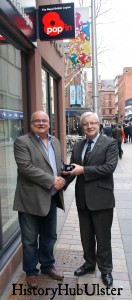This is the second part of a long read. Read the first part of the article here.
Influenza in Ulster
The first outbreak of influenza in the province of Ulster visited the towns of Belfast, Lurgan, Portadown and Londonderry during June 1918, causing havoc as businesses had to close or function on reduced staff. Services were disrupted throughout these towns. In other Ulster towns such as Larne, Clones, Cookstown, Newry and the county of Donegal, their main influenza outbreaks occurred during the second and third waves in the autumn of 1918 and spring of 1919.
In Ulster, as elsewhere in Ireland and Great Britain, it was the local authorities and their Medical Officers of Health that had responsibility for public health in their respective towns and cities. They were tasked with the management of the disease at a local level. It was the Poor Law medical system of the Union infirmary and dispensary districts – administered by the Board of guardians – that bore the brunt of medical care. However the Local Government Board for Ireland (LGBI) controlled the activities of the boards of guardians in relation to the administration of the dispensary medical system, union infirmaries and fever hospitals it also controlled the administration of the Public Health Acts by the rural, urban and County Councils.[36] So how did these combined forces in Ulster respond to the public health crisis of epidemic influenza?
During the first wave the Medical Superintendent Officer of Health for Belfast Corporation, Dr Hugh W. Bailie ordered school closures and recommended the thorough disinfection of cinemas once or twice a day. He also proposed sending out his public health department inspectors around their districts to advise people on what measures they should take if they contracted influenza.[37] In Londonderry the main recommendation by the corporation was school closures.[38] This is surprising as influenza was rampant in the city with burials at the City Cemetery reaching a record number of 50 during the week ending 6 July 1918 and nearly 20 burials alone on Monday 8 July 1918.[39] There was no evidence that any specific steps were taken to prevent the spread of influenza in either Lurgan or Portadown during the first wave. Again this is noteworthy as there were 31 influenza deaths were recorded in the town area from the middle of June until the end of July 1918.[40] The lacklustre response from these local authorities during the first wave may be due to the consensus that this outbreak of the disease was a seasonal flu and therefore unworthy of any particular action.
During the second wave, there was a more proactive response by local authorities in Ulster towns as many of the councils took preventative measures. A common recommendation was the closure of day, Sunday and technical schools. It was not a compulsory measure but in general, school managers adhered to it. However, Methodist College in Belfast remained open during this virulent wave with tragic results. Influenza hit the school at the end of October 1918. Student boarders contracted the flu and only the Medical Officer, matron and headmaster of the school avoided contracting the disease. Sadly during November, two members of staff, George Manning and the Rev P. P O’Sullivan, as well as one of the boarders, Oliver Crawford, aged 15 died from pneumonia following on from influenza.[41] The Friends school in Lisburn may also have regretted its decision to remain open. Influenza was rife and by 31 October 1918 only 17 boarders and two members of staff had not contracted the disease. Helen Clarke, a day pupil died on 31 October 1918. When pupils Anna Magowan and Sadie Walsh died on 3 November and 8 November 1918 respectively, it was then decided to close the school and send the remaining 16 pupils home. The larger dormitories in the school acted as wards where the remaining students who were ill were nursed. The housekeeper, Miss McCullough and headmaster’s daughter, Frances Ridges, a student from Queen’s University, Belfast, worked as nurses but unfortunately they both lost their lives to influenza. The school eventually opened again in early January 1919.[42]
In Ulster, as with the rest of United Kingdom, several councils singled out places of entertainment for closure and ventilation under the pretext that people gathered there and could therefore spread the disease. In Newry both local cinemas closed for one week at the Medical Officer of Health’s request, however, one of them, the Imperial, re-opened without consulting the Public Health Authority, while the other, the Frontier, remained closed.[43] The Public Health authorities in Belfast, Portadown and Newtownards requested permission from the LGBI to close cinemas in their towns. However, the LGBI advised that they had no powers to close the cinemas, as this action was not approved in any part of the United Kingdom.[44]
Mass gathering of people in the cinemas, theatres and trams were not the only cause for concern and the Irish News feared that the congregation of huge masses of people on the streets during the armistice celebrations would further spread the disease.[45] It has been suggested that an ironic impact of the war was the extra infections and deaths that occurred as a result of the armistice celebration, where the celebrations became the foci of new or recurring outbreaks of influenza.[46] In Belfast the armistice celebration occurred during the peak of the second influenza wave in the city. Interestingly, deaths from pneumonia – a common complication of influenza – peaked in Belfast on 23 November 1918 not long after these celebrations took place.[47] Whether the celebrations aided this peak is a matter for debate.
In Belfast, Larne and Cookstown, public notices of preventative measures were displayed in public places, published in the local newspapers and printed on handbills for distribution. These notices recommended avoiding crowded gatherings, good ventilation and cleanliness in homes and discouraged spitting on the streets. Influenza sufferers should go to bed early and remain there until completely recovered.[48]
The Irish tradition of waking the dead came in for much criticism as it was feared that the custom would aid in the spread of infectious disease. Both Newry and Ballyclare councils produced public notices which recommended the prompt burial of influenza victims without a wake being held for the deceased. However, again there was no official central government support given to forbid the holding and attendance at wakes. Again it was not a compulsory measure but only a strong recommendation as the local Public Health Authorities had no powers to stop wakes. These were not the only towns to criticise the tradition of holding wakes In Dublin during the second wave, an Irish Times editorial complained that attending wakes of people who had died from influenza was an objectionable practice that was believed to be a fruitful cause of the spread of infection and that this custom more than anything else frustrated the efforts of the public health authorities to eradicate influenza.[49]
There were valid objections to ‘waking the dead’. Contemporary opinion was that infection was thought to remain in the corpse and therefore could be spread to the living. However, there is no evidence that this was the case with respect to the influenza virus.[50] Waking the body in an open coffin may not have spread the disease through the corpse. However, anyone attending the wake who had the ‘flu could bring the infection to a small house where many people congregated in confined spaces. Once there it could be spread quickly within a community.
Medical Response
The main medical response in towns was by the Poor Law Union under the auspices of union infirmaries and the dispensary system. However, these institutions were unprepared for the number of influenza patients needing treatment. During the first wave in Belfast the number of influenza patients admitted to the union infirmary was so large that it greatly increased the workload in the hospital and the Visiting Medial Officer, Dr Gardner Robb stated:
‘Never in my recollection has the strain on the staff been so great as during the past few weeks.’ The whole staff has worked most enthusiastically and the generous recognition of our efforts by the Board is most appreciated by all.[51]
The Lurgan union infirmary was also under pressure and there were reports that it had not been so full in over thirty years due to an influx of influenza sufferers.[52] The workhouse infirmaries throughout Ireland were extremely busy. During 1918 the number of deaths in Irish workhouses increased by 3,329 on the previous year with influenza and pneumonia deaths rising by 2,551.[53]
There was also a scarcity of medical professionals as many doctors were serving at the western front. Temporary doctors were difficult to source for both the union infirmaries and the dispensary districts. Doctors that were available could, in many cases, demand whatever salary they wanted much to the annoyance of the guardians. However these doctors were justified in requesting a higher weekly salary as they were under severe pressure. During 1918 the Medical officers of health worked long hours to treat their patients, paying 100,000 more home visits during this period than in the previous year, indicating not only the virulence of the disease throughout Ireland but also the work pressure that dispensary doctors were under during this pandemic.[54]
Cures and treatments
Unsurprisingly, as the real cause of influenza was unknown at the time and as there is still no known cure for the disease, there was little consensus among the Irish medical profession on the best treatment for, or, prevention against the disease, which resulted in many cures and treatments being suggested. According to Ida Milne, some Irish doctors recommended gargling with a tincture of creosote or a solution of permanganate of potash; calomel (as a purgative); oxygen; stimulants (such as strychnine); some preparation of opium for sleeplessness.[55] An article in the Armagh Guardian advised that if attacked by influenza, the sufferer should at once take a dose of opening medicine such as castor oil, and if possible take a hot bath and go to bed and send for the doctor. It advised that to work or walk off an attack is dangerous.[56] A popular treatment choice was quinine and the Belfast MOH, Dr Bailie recommended taking quinine tablets of between 2 and 5 grains twice daily as a tonic and preventative.[57]
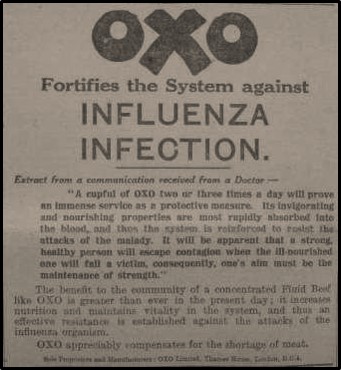
Some doctors widely endorsed the use of alcohol in influenza cases to relieve pain and bolster strength.[58] This treatment was so popular that in February 1919, the Dublin Public Health Committee requested the War Cabinet to call for the immediate release of supplies of whiskey in the interests of public health.[59] The lack of a cure for influenza meant that people resorted to over-the-counter cures to help treat the disease.[60] An immense assortment of products claimed curative or preventative powers against influenza. Disinfection was considered a good preventative as influenza was believed to be a bacterial infection. Lifebuoy soap claimed to be a ‘reputable germicide and sure disinfectant.’[61]
A nationally established disinfectant proclaimed ‘Guard against Influenza by the daily use of Jeyes’ Fluid.’[62] Disinfection with Jeyes’ Fluid was one of the recommendations of the Dublin Medical Officer of Health, Dr Charles Cameron in dealing with influenza.[63] Oxo and Bovril were popular beef teas of the day and were thought to strengthen the body against the onslaught of disease.[64] So popular were these products that during December 1918, a series of advertisements apologised for the shortage of Bovril during the influenza outbreak.[65] Bovril was considered a very important form of nourishment during the epidemic. So much so that during November 1918 the Belfast Guardians increased the nurses’ Bovril rations by one quarter of an ounce per day to boost their diet to help them cope with their increased workload
In reality there was no cure for influenza and traditional nursing care provided the best and only effective treatment for the disease.[66] However, nurses like doctors were in short supply as many professional nurses had also volunteered for both army and naval medical corps during the war.[67] This situation was further exacerbated when remaining nurses started to contract influenza themselves. In Ulster where there were numerous reports of professional nurses being infected with influenza during the course of their duties. Workhouse infirmaries reported the absence of their nursing staff due to influenza. Many nurses in the Belfast Infirmary contracted influenza during the first and second waves and six died from the disease.[68] Similarly, during the second wave several nurses in the Londonderry Union contracted influenza with two fatalities.[69] Also during the second wave, eight nurses in the Lurgan Union infirmary contracted influenza and two later died from the complication pneumonia.[70]
The medical response during the second and third waves was similar to that of the first. Influenza sufferers availed of treatment and medicines through the dispensary system and the workhouse infirmaries. The demands of war impacted on the workhouse infirmaries because in many cases wards or entire workhouse hospitals were requisitioned for military patients. The workhouse infirmaries were filled to capacity and suffered from overcrowding.In Strabane, the military acquired the workhouse for treatment of troops just prior to the outbreak of influenza in October 1918 and most of the inmates were sent to the Londonderry workhouse.[71] The chairman of Strabane council was very concerned about the lack of treatment and hospital accommodation for the sick poor in the town. The council eventually convinced the guardians to provide hospital accommodation for those suffering from influenza but not before a young boy, who was forced to lay ‘on a bed of straw and bags’, had died from influenza.[72]

The local authority response to influenza in towns like Belfast, Londonderry Lurgan and Portadown was poor but the United Kingdom as a whole did not respond effectively to the crisis. Central government was pre-occupied by the war and left it up to individual local authorities to deal with influenza at a local level. In Manchester, the public health committee—aware of the gravity of the influenza pandemic — were more proactive. They supplied additional help to nurse and provide domestic assistance to influenza sufferers where it was needed in the city. They also supplied food and coal for those unable to provide the same for themselves. It has been suggested that in Manchester public aid with food, fuel and nursing during the pandemic was of much more value than treatment by local physicians in the city.[73]
There is no evidence that the bigger industrial towns such as Belfast, Londonderry and Lurgan took similar measures as Manchester to help their citizens. Nevertheless, some Ulster towns took more concrete measures to help the sick poor. Influenza was rife in Newry with many people dying of the complication pneumonia. Newry council was aware that the poor needed more substantial charitable help especially with nutrition. The provision of nourishing food was deemed important. The council arranged for two Newry creameries to supply sufficient quantities of free milk for distribution due to the influenza outbreak.[74] The staff of the domestic department of the Newry Technical School provided nourishing foodstuff for the sick such as beef tea and mutton broth during their closure. This work was discontinued on 25 November 1918 when the school re-opened.[75]
Despite this aid, the situation in Newry was very serious. A Relief of Distress Fund Committee was formed to ‘consider the best means of meeting the exceptional expenditure that has been and is being incurred by the various charitable organisations in the relief of distress arising out of the influenza epidemic.’[76] A circular was sent out inviting subscriptions to the fund and it was hoped that a sum of at least £1,000 would be raised.[77] The fund was closed on to 31 December 1918 and a total £734 4s. 2d. was raised and was allocated as follows: three-quarters (£550 13s. 2d.), to the Catholic Charitable Organisations such as the St Vincent de Paul Society, and one quarter (£183 11s.), to the local Protestant clergymen for distribution.[78] The fund reimbursed the St Vincent de Paul Society for the expenditure it had already incurred in Newry, where it had spent several hundred pounds on clothing, coal, groceries, butter, milk and other necessities for the poor during the pandemic. This indicated that charities in the town rose to the challenges imposed by the pandemic in a timely manner.[79]
In Cookstown, although both the council and the guardians made efforts to combat the pandemic, it was the middle class population of Cookstown who made the biggest contribution in dealing with the effects of influenza in the town. As in Newry, a subscription list was opened and a committee was formed to look after the sick poor in the town and dispensary district. Many local trained ladies volunteered to act as nurses in the district offering their services for no payment. The Sick Nursing Society used the Technical School kitchen to provide nourishing food, not only for the sick poor in the town, but, also for those families that could afford to feed themselves but were too sick to provide food and nurture for other family members. This was a popular service with up to 170 families in the town and district receiving this aid.[80]
In Clones the workhouse hospital was full and doctors were working to full capacity. The Clones Relief Committee was formed to assist families incapacitated by influenza with both nourishment and nursing. The committee established a kitchen in the Town Hall and prepared and distributed soup, beef tea and porridge to those patients requiring them. The St Vincent de Paul society placed their funds at the disposal of the relief committee. The committee did not raise a public subscription in the town but instead they took action first and sought reimbursement later from the guardians for any expenses incurred.[81]
In conclusion the
response from most local authorities in Ulster consisted of applying
preventative measures such as closing schools, producing public notices,
encouraging disinfection of factories, cinemas and public buildings. However they lacked the authority from the
central body of the LGBI to enforce recommendations such as closure of cinemas
or prevention of wakes. The boards of
guardians actively tried to obtain sufficient medical personnel to help during
the pandemic and in general adhered to the requests of their Medical Officers
of Health with respect to treatment of the disease. However public aid with food, fuel
and nursing during the pandemic could be of much more value than treatment by
local doctors.[82] So although local guardians in Ulster actively tried
to obtain sufficient medical personnel to help during the pandemic, maybe if
they and the local councils in towns such as Belfast, Londonderry and Lurgan
looked towards the physical nourishment and welfare of the poor, then the
influenza death toll may have not been so high.
Dr. Patricia Marsh: Queen’s University, Belfast
Dr. Marsh will be giving a talk entitled “The Spanish Influenza Pandemic in Antrim and Down 1918-1919” at Bangor Library on Thursday 21st February 2019 at 7.30pm, and Lisburn Road Library on Wednesday 27th February 2019 at 6.30pm 6.30 to 7.30 p.m.
[36]Report of the Irish Public Health Council on the public health and medical services in Ireland [Cmd 761], H. C. 1920, xvii 2, 1075, p. 4.
[37] Marsh, ‘The effect of the 1918-19 influenza pandemic on Belfast’, pp. 66-7.
[38]Irish News, 25 June 1918; Derry Journal, 26 June 1918; Dungannon Democrat, 26 June 1918.
[39] Derry Journal, 10 July 1918; Irish News, 9 July 1918.
[40] Lurgan Medical Officer of Health Report, 5 Aug. 1918 (P.R.O.N.I., Lurgan Medical Officer of Health Report, LA/51/9D/6); Lurgan Mail, 10 Aug. 1918.
[41] John Watson Henderson, Methodist College, Belfast, 1868-1938: A survey and retrospect Vol. 1 (Belfast, 1939), p. 271.
[42]Neville H. Newhouse, A History of the Friends School, Lisburn(Lurgan, 1974), pp. 90-1.
[43]Newry Reporter, 19 Nov. 1918.
[44] Marsh, ‘The effect of the 1918-19 influenza pandemic on Belfast’, pp 71-73.
[45]Irish News, 13 Nov. 1918.
[46] Niall Johnson, Britain and the 1918-19 influenza pandemic: A dark epilogue, (London/New York, 2006), p.193.
[47]Weekly returns of births and deaths in the Dublin Registration area and in eighteen of the principal towns in Ireland 1918, (Dublin, 1919).
[48]Irish News, 31 Oct. 1918; Belfast News-Letter, 31 Oct. 1918.
[49][49]Freeman’s Journal, 2 Nov 1918; Irish Independent, 2 Nov 1918, Irish Times, 4 Nov 1918
[50] S. S. Bakhshi, ‘Code of practice for funeral workers: Managing infection risk and body bagging’, in Communicable Disease and Public Health, 4:4 (2001), p. 284.
[51] Belfast Board of Guardians Meeting, 9 July 1918 (P.R.O.N.I., Belfast Union Minute Books, BG/7/A/100).
Irish News, 10 July 1918; Belfast News-Letter, 10 July 1918.
[52]Belfast Evening Telegraph, 19 July 1918, Belfast News-Letter, 20 July 1918, Armagh Guardian, 26 July 1918.
[53]Annual Report of the Local Government Board for Ireland for the year ended 31st March 1919, p. xxiii.
[54]Annual Report of the Local Government Board for Ireland for the year ended 31st March 1919, p. xxvi.
[55] Ida Milne’s contribution to Guy Beiner, Patricia Marsh and Ida Milne ‘Greatest killer of the twentieth century: the Great Flu of 1918-19’ History Ireland (March/April 2009), pp. 40-43.
History Ireland article
[56] Armagh Guardian, 08 Nov 1918
[57]Irish News, 31 Oct 1918 and Belfast News-Letter, 31 Oct 1918
[58]Lori Loeb, ‘Beating the flu: orthodox and commercial responses to influenza in Britain, 1889–1919’ Social History of Medicine 18:2 (2005), p. 220.
[59]Irish Independent, 22 Feb. 1919.
[60]Loeb, ‘Beating the flu’, p. 203.
[61]Northern Whig, 28 Nov. 1918; Ulster Herald, 15 Feb. 1919; Belfast News-Letter, 12 Mar. 1919; Irish News, 18 Mar. 1919, 25 Mar. 1919.
[62]Belfast News-Letter, 5 Mar. 1919, 12 Mar. 1919, 19 Mar. 1919.
[63]Lurgan Mail, 2 Nov. 1918; Larne Times, 2 Nov. 1918; Ballymena Weekly Telegraph, 2 Nov. 1918; County Down Spectator, 2 Nov. 1918.
[64]Loeb, ‘Beating the flu’, p. 220.
[65]Irish Independent, 23, 27 Nov. 1918, 4, 13, 23 Dec. 1918; Irish Times, 29 Nov. 1918, 7, 21, 28, 30 Dec. 1918.
[66] Carol R. Byerly, Fever of war: The influenza epidemic in the U. S. army during World War 1 (New York/London, 2005), p. 144.
[67] Barrington, Health, medicine and politics in Ireland, p. 73.
[68] Marsh, ‘The effect of the 1918-19 influenza pandemic on Belfast’, p. 32.
[69] Londonderry Board of Guardians Meeting, 9 Nov. 1918 (P.R.O.N.I., Londonderry Union Minutes, BG/2/A/33), Derry Journal, 11 Nov. 1918.
[70] Belfast News-Letter, 23 Nov. 1918, Belfast News-Letter, 7 Dec. 1918; Irish News, 23 Nov. 1918; Lurgan Mail, 23 Nov. 1918; Lurgan Board of Guardians Minutes, 21 Nov. 1918, 5 Dec. 1918 (P.R.O.N.I., Lurgan Union Minute Book, BG/22/ A/114).
[71] Strabane Board of Guardians Meetings, 27 Sept. 1918 and 8 Oct. 1918 (P.R.O.N.I., Strabane Union Minute Book, BG/27/A/50).
[72]Belfast-Newsletter, 6 Nov. 1918; Derry People, 9 Nov. 1918; Ulster Herald, 9 Nov. 1918.
[73] Fred, R Van Hartesveldt, ‘Manchester’, in Fred van Hartesveldt (ed.) The 1918-1919 Pandemic of Influenza: The Urban Impact in the Western World (Lewiston, Queenstown, Lampeter: The Edward Mellon Press, 1992), p. 103.
[74]Newry Urban District Council meeting, 4 Nov. 1918 (P.R.O.N.I., Newry Urban District Council minutes, LA58/2CA/6).
[75]Newry Reporter, 29 Oct.1918; Newry Reporter, 28 Nov. 1918.
[76]Newry Reporter, 16 Nov. 1918.
[77]Newry Reporter, 16 Nov. 1918.
[78]Newry Reporter, 11 Jan. 1919; Belfast News-Letter, 13 Jan. 1919.
[79] Patricia Marsh, “‘An enormous amount of distress among the poor’: Aid for the Poor in Ulster during the Influenza Pandemic of 1918-1919’ in Poverty and Welfare in Ireland 1838-1948, Eds. Crossman, Virginia and Gray Peter, (IAP, 2011), pp, 217-218.
[80]Irish News, 18 Nov 1918, Belfast News-Letter, 18 Nov 1918, Mid Ulster Mail. 17 Nov 1918, 30 Nov. 1918 and 7 Dec. 1918.
[81]Belfast News-Letter, 21 Nov. 1918, Anglo-Celt 30 Nov. 1918, 1 Feb. 1919, 15 Feb. 1919.
[82] Van Hartesveldt, ‘Manchester’, p 103

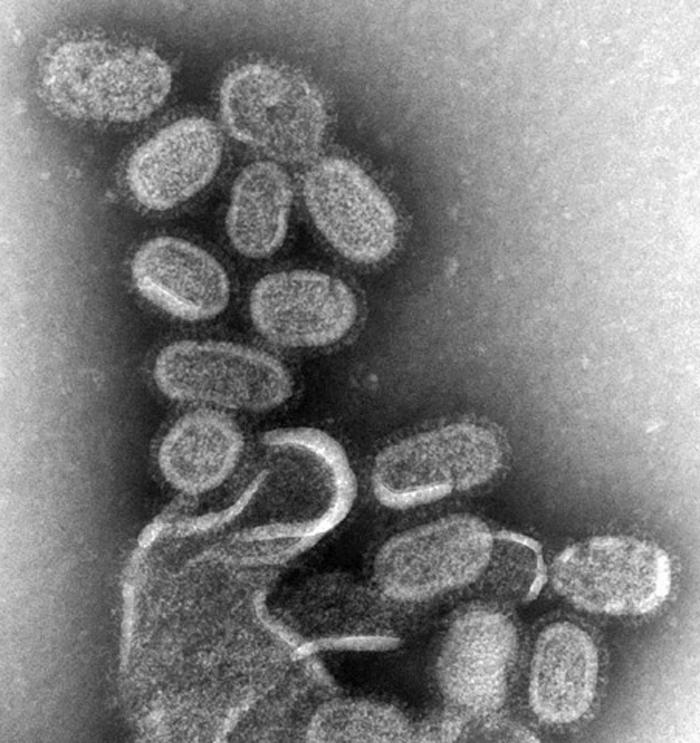







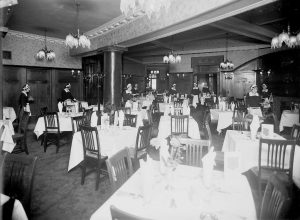

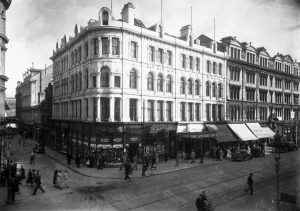
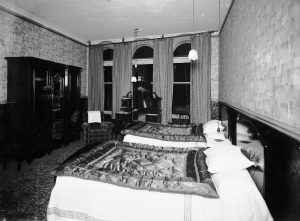

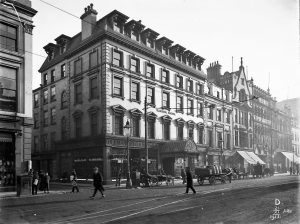 Marketing material of the time proudly proclaimed that “It is highly probable that no establishment in the City of Belfast is so well known in all quarters of the globe as the Imperial Hotel “
Marketing material of the time proudly proclaimed that “It is highly probable that no establishment in the City of Belfast is so well known in all quarters of the globe as the Imperial Hotel “
 The Cleaver family originated in Scotland where one of the earliest recorded marriages took place between William Cleaver and Elizabeth Dunstone on 2nd February 1770. William served in the army, and the couple’s children were born and raised in the parish of Kilmallie, near Fort William in the Scottish Highlands. Upon his death in 1787, the family moved to Bishopstone, a small village close to the south coast of England in East Sussex.
The Cleaver family originated in Scotland where one of the earliest recorded marriages took place between William Cleaver and Elizabeth Dunstone on 2nd February 1770. William served in the army, and the couple’s children were born and raised in the parish of Kilmallie, near Fort William in the Scottish Highlands. Upon his death in 1787, the family moved to Bishopstone, a small village close to the south coast of England in East Sussex.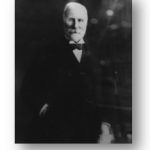 John Cleaver was born in Bishopstone on 23rd September 1841, the great grandson of William Cleaver of Fort William. He served his apprenticeship in retail in London, and in a bid to further his career, he crossed the Irish Sea in 1865 to manage one of the departments in the established firm of James Lindsay & Co; general drapers, silk mercers and linen merchants at the Ulster Arcade on Donegall Place. The Lindsay family had themselves made their way to Ireland from Scotland in 1678, where they played an active role in the Relief of Derry in 1689, before moving to Belfast to establish a “woollen, linen and haberdashery warehouse” at 15 Bridge Street, the then centre of commerce in the town, in 1822.
John Cleaver was born in Bishopstone on 23rd September 1841, the great grandson of William Cleaver of Fort William. He served his apprenticeship in retail in London, and in a bid to further his career, he crossed the Irish Sea in 1865 to manage one of the departments in the established firm of James Lindsay & Co; general drapers, silk mercers and linen merchants at the Ulster Arcade on Donegall Place. The Lindsay family had themselves made their way to Ireland from Scotland in 1678, where they played an active role in the Relief of Derry in 1689, before moving to Belfast to establish a “woollen, linen and haberdashery warehouse” at 15 Bridge Street, the then centre of commerce in the town, in 1822.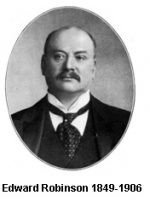 It was during his time at Lindsay Brothers, that John Cleaver met Edward Robinson, a young man from Ballymena, who had earlier secured for himself an apprenticeship with the same company. His father Alexander, was a woollen draper in the County Antrim town. Both men soon realised the enormous potential for the development of the sale of Irish linen products, and with financial assistance from their families, set up a business partnership in premises on Castle Place in 1870, styled as Robinson & Cleaver.
It was during his time at Lindsay Brothers, that John Cleaver met Edward Robinson, a young man from Ballymena, who had earlier secured for himself an apprenticeship with the same company. His father Alexander, was a woollen draper in the County Antrim town. Both men soon realised the enormous potential for the development of the sale of Irish linen products, and with financial assistance from their families, set up a business partnership in premises on Castle Place in 1870, styled as Robinson & Cleaver. 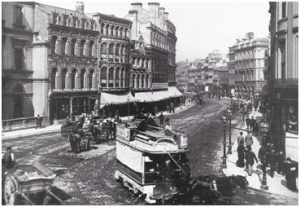 The success of their business was based on the fact that until that time, it had been almost impossible to obtain locally produced goods at reasonable prices. They were quick to identify this gap in the market and within a short space of time, the business had expanded and the partnership moved to larger premises on High Street (left) in 1879. The potential for growth of such a business in Belfast at that time was phenomenal.
The success of their business was based on the fact that until that time, it had been almost impossible to obtain locally produced goods at reasonable prices. They were quick to identify this gap in the market and within a short space of time, the business had expanded and the partnership moved to larger premises on High Street (left) in 1879. The potential for growth of such a business in Belfast at that time was phenomenal.
 In addition to raising a large family, the business at High Street continued to expand. Belfast was fast becoming one of the leading manufacturing cities of the British Empire, with markets for products produced in North East Ireland opening up across the civilised world. The partners were not slow to capitalise on this phenomenal growth and soon they were supplying high quality items of Irish linen to households across the United Kingdom. Soon the company outgrew their premises on High Street and by the mid-1880s the partners began to look for larger premises. They purchased one of the last residential houses on Donegall Place (see right) which had a large garden onto Donegall Square North, and quickly commissioned one of the leading architects of the day, Young & McKenzie, to design a building that would be fitting for the business they had grown over the past 15 years. The vast majority of parcels despatched from Belfast came from the house of Robinson & Cleaver and the company pioneered overseas sales via their brochures to homes and businesses across the empire.
In addition to raising a large family, the business at High Street continued to expand. Belfast was fast becoming one of the leading manufacturing cities of the British Empire, with markets for products produced in North East Ireland opening up across the civilised world. The partners were not slow to capitalise on this phenomenal growth and soon they were supplying high quality items of Irish linen to households across the United Kingdom. Soon the company outgrew their premises on High Street and by the mid-1880s the partners began to look for larger premises. They purchased one of the last residential houses on Donegall Place (see right) which had a large garden onto Donegall Square North, and quickly commissioned one of the leading architects of the day, Young & McKenzie, to design a building that would be fitting for the business they had grown over the past 15 years. The vast majority of parcels despatched from Belfast came from the house of Robinson & Cleaver and the company pioneered overseas sales via their brochures to homes and businesses across the empire.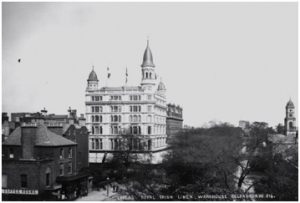 The ‘Royal Irish Linen Warehouse’ of Robinson & Cleaver opened for business on September 1888, the same year that Belfast received its charter as a city. With success came great wealth for the founding partners and by this time, they would have been the equivalent of millionaires in today’s money. This precipitated a move to a larger house on the Malone Road for the Cleaver family – a large Victorian terrace opposite Fisherwick Presbyterian Church.
The ‘Royal Irish Linen Warehouse’ of Robinson & Cleaver opened for business on September 1888, the same year that Belfast received its charter as a city. With success came great wealth for the founding partners and by this time, they would have been the equivalent of millionaires in today’s money. This precipitated a move to a larger house on the Malone Road for the Cleaver family – a large Victorian terrace opposite Fisherwick Presbyterian Church. In 1892, such was the success of Robinson & Cleaver, that John Cleaver moved residence again, this time to the estate of ‘Dunraven’ on the Malone Road. Dunraven, a large Italianate Villa, had been built for the timber magnate and shipowner, James Porter Corry in 1870. It extended over several acres with its own lake and extensive parkland. It was in this house that John and Mary would spend the rest of their lives.
In 1892, such was the success of Robinson & Cleaver, that John Cleaver moved residence again, this time to the estate of ‘Dunraven’ on the Malone Road. Dunraven, a large Italianate Villa, had been built for the timber magnate and shipowner, James Porter Corry in 1870. It extended over several acres with its own lake and extensive parkland. It was in this house that John and Mary would spend the rest of their lives.  By 1900, his eldest son, (aged 29) Arthur Spencer Cleaver, in addition to becoming a director of Robinson & Cleaver, had embarked on a military career and became a second Lieutenant in the Southern Division of the Mid Ulster (Royal Field) Artillery (left) – a regiment within the British Army. He removed to London, primarily to look after the Regent Street store at the same time becoming an Honorary Lieutenant Colonel with the Royal Garrison Artillery, 1st Reserve Battery.
By 1900, his eldest son, (aged 29) Arthur Spencer Cleaver, in addition to becoming a director of Robinson & Cleaver, had embarked on a military career and became a second Lieutenant in the Southern Division of the Mid Ulster (Royal Field) Artillery (left) – a regiment within the British Army. He removed to London, primarily to look after the Regent Street store at the same time becoming an Honorary Lieutenant Colonel with the Royal Garrison Artillery, 1st Reserve Battery.  It was however his wife, Adelaide, who achieved notoriety as an adventurer and women pioneer in aviation in the 1920s and 30s. She was an avid mountain climber, expert driver and skilled motor mechanic. Adelaide Franklin Pollock was born in Newtownards in 1896, the eldest daughter of the Rt Hon Hugh MacDowell Pollock, first Minister of Finance in the Government of Northern Ireland created in 1921. Having developed an important flour importing business, Pollock was independently wealthy, and as Chairman of the Belfast Harbour Commissioners had one of the docks named in his honour. Coming from such a privileged position within Ulster Society this was the type of union John Cleaver would have nurtured and encouraged for his offspring.
It was however his wife, Adelaide, who achieved notoriety as an adventurer and women pioneer in aviation in the 1920s and 30s. She was an avid mountain climber, expert driver and skilled motor mechanic. Adelaide Franklin Pollock was born in Newtownards in 1896, the eldest daughter of the Rt Hon Hugh MacDowell Pollock, first Minister of Finance in the Government of Northern Ireland created in 1921. Having developed an important flour importing business, Pollock was independently wealthy, and as Chairman of the Belfast Harbour Commissioners had one of the docks named in his honour. Coming from such a privileged position within Ulster Society this was the type of union John Cleaver would have nurtured and encouraged for his offspring.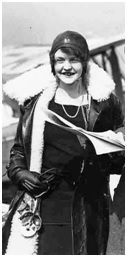 See thread on Rootschat here:
See thread on Rootschat here:  Gordon Neil Spencer ‘Mouse’ Cleaver was born in Stanmore, Middlesex, in 1910, and educated at Harrow. As an accomplished skier, he was the inaugural winner of the ‘Hahnenkammrennen Combined’ in Austria in 1931. The ‘Cleaver Cup’ was subsequently named after his success on the slopes. He joined 601 Fighter Squadron (The Millionaire’s Squadron) Auxiliary Air Force in 1937, being promoted to the position of Flying Officer in October 1938. Upon the outbreak of the Second World War he was mobilised in November 1939, travelling to France with his Squadron to Merville in Northern France. He claimed 7 confirmed “kills” during the Battle of Britain before his hurricane was shot down during combat over Winchester. Although he baled out, the fragments from the Perspex canopy on his plane, shattered into his eyes and face blinding him in the right eye. For his valour, he was awarded the Distinguished Flying Cross (DFC). Despite his injuries he remained in the RAF throughout the war, being released on medical grounds in November 1943, retaining the rank of Squadron Leader. Following on from the injuries he received, Cleaver underwent 18 operations on his eyes under the accomplished eye surgeon Harold Ridley. It was during work carried out during these procedures that Ridley developed the intraocular lens, a major development in repairing damage to the human eye.
Gordon Neil Spencer ‘Mouse’ Cleaver was born in Stanmore, Middlesex, in 1910, and educated at Harrow. As an accomplished skier, he was the inaugural winner of the ‘Hahnenkammrennen Combined’ in Austria in 1931. The ‘Cleaver Cup’ was subsequently named after his success on the slopes. He joined 601 Fighter Squadron (The Millionaire’s Squadron) Auxiliary Air Force in 1937, being promoted to the position of Flying Officer in October 1938. Upon the outbreak of the Second World War he was mobilised in November 1939, travelling to France with his Squadron to Merville in Northern France. He claimed 7 confirmed “kills” during the Battle of Britain before his hurricane was shot down during combat over Winchester. Although he baled out, the fragments from the Perspex canopy on his plane, shattered into his eyes and face blinding him in the right eye. For his valour, he was awarded the Distinguished Flying Cross (DFC). Despite his injuries he remained in the RAF throughout the war, being released on medical grounds in November 1943, retaining the rank of Squadron Leader. Following on from the injuries he received, Cleaver underwent 18 operations on his eyes under the accomplished eye surgeon Harold Ridley. It was during work carried out during these procedures that Ridley developed the intraocular lens, a major development in repairing damage to the human eye. His second son, (John) Martin Cleaver, born in 1871, was educated in England and Germany, gaining a BA from the Royal University of Ireland (precursor to QUB) and graduating from TCD with a law degree in 1893. He set up his own practice as a solicitor later that year at premises on Wellington Place. In 1897, he took into partnership William Fulton, whose father John Fulton, was a linen manufacturer at the firm of John Fulton & Co on Ormeau Avenue. The partnership was style as Cleaver & Fulton. Both the Cleavers and Fultons were Methodists, with John Fulton being greatly interested in Foreign Missions, in addition to being solicitor to the Board of Governors at Methodist College. Soon after the partnership was established, Martin Cleaver, influenced by Fulton’s vision, retired from the law, devoting his whole time to the Egypt General Mission of which he was one of the founders. He arrived in Alexandria, Egypt on 31st January 1898, one of a group of 7 missionaries where he met Aileen Mary White, who had also carried out missionary work in Egypt. After their marriage, they both returned to Alexandria, but after four years of travelling in North Africa, his health broke down, and he took up residence in London as Secretary to the Mission.He later went on to co-found the ‘Fellowship of Faith for the Muslims’ (1915) an international fellowship of Christians who have a concern for the Muslim world, publishing such pamphlets as “Why do the Muslims need the Gospel?”Having been at Keswick in 1915, he returned to visit his father at Dunraven in Belfast, but became ill and died during that visit in August of that year. Both J Martin Cleaver and his wife Aileen are buried at Belfast City Cemetery. The company he established in 1893, Cleaver Fulton Rankin, remains one of Northern Ireland’s leading law firms.
His second son, (John) Martin Cleaver, born in 1871, was educated in England and Germany, gaining a BA from the Royal University of Ireland (precursor to QUB) and graduating from TCD with a law degree in 1893. He set up his own practice as a solicitor later that year at premises on Wellington Place. In 1897, he took into partnership William Fulton, whose father John Fulton, was a linen manufacturer at the firm of John Fulton & Co on Ormeau Avenue. The partnership was style as Cleaver & Fulton. Both the Cleavers and Fultons were Methodists, with John Fulton being greatly interested in Foreign Missions, in addition to being solicitor to the Board of Governors at Methodist College. Soon after the partnership was established, Martin Cleaver, influenced by Fulton’s vision, retired from the law, devoting his whole time to the Egypt General Mission of which he was one of the founders. He arrived in Alexandria, Egypt on 31st January 1898, one of a group of 7 missionaries where he met Aileen Mary White, who had also carried out missionary work in Egypt. After their marriage, they both returned to Alexandria, but after four years of travelling in North Africa, his health broke down, and he took up residence in London as Secretary to the Mission.He later went on to co-found the ‘Fellowship of Faith for the Muslims’ (1915) an international fellowship of Christians who have a concern for the Muslim world, publishing such pamphlets as “Why do the Muslims need the Gospel?”Having been at Keswick in 1915, he returned to visit his father at Dunraven in Belfast, but became ill and died during that visit in August of that year. Both J Martin Cleaver and his wife Aileen are buried at Belfast City Cemetery. The company he established in 1893, Cleaver Fulton Rankin, remains one of Northern Ireland’s leading law firms.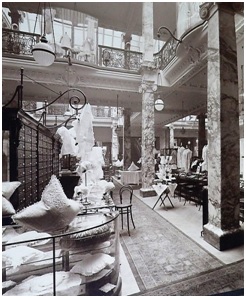 John Cleaver’s third son, (James) Frederick was born at Ashley Villa on 8th June 1875, and after being educated in Belfast and Germany, he travelled the world, visiting Australia and New Zealand, before following his father into the family business at Robinson & Cleaver, in 1895. The firm had developed branches throughout the UK including Regent Street, London; and Church Street, Liverpool. The importance of the company to the economy of Belfast cannot be underestimated. Robinson & Cleaver sent more parcels containing linen products of Irish manufacture out of the city of Belfast than any other business. Their store on London’s Regent Street was one of the most opulent and exclusive in the capital (right). He soon became Managing Director of the firm at its headquarters on Donegall Place (1906) and resided at a house called ‘Bishopstone’ on Deramore Park, recalling the origins of his father’s home in Essex. He married, in 1901, Sarah Hammond Fulton, eldest daughter of John Fulton and sister of the partner of his brother’s law firm, Cleaver and Fulton (see J Martin Cleaver).
John Cleaver’s third son, (James) Frederick was born at Ashley Villa on 8th June 1875, and after being educated in Belfast and Germany, he travelled the world, visiting Australia and New Zealand, before following his father into the family business at Robinson & Cleaver, in 1895. The firm had developed branches throughout the UK including Regent Street, London; and Church Street, Liverpool. The importance of the company to the economy of Belfast cannot be underestimated. Robinson & Cleaver sent more parcels containing linen products of Irish manufacture out of the city of Belfast than any other business. Their store on London’s Regent Street was one of the most opulent and exclusive in the capital (right). He soon became Managing Director of the firm at its headquarters on Donegall Place (1906) and resided at a house called ‘Bishopstone’ on Deramore Park, recalling the origins of his father’s home in Essex. He married, in 1901, Sarah Hammond Fulton, eldest daughter of John Fulton and sister of the partner of his brother’s law firm, Cleaver and Fulton (see J Martin Cleaver). Fred Cleaver was a staunch Unionist and Ulsterman. He was an active member of the Belfast Chamber of Commerce; the Royal Ulster Agricultural Society; the Belfast Harbour Board; The Belfast Chamber of Trade, and was Chairman of the Ulster Tourist Development Association. As a member of the Ulster Unionist Council, he took an active part in the Anti Home Rule campaign and he took a leading part in the organising and equipping of the Ulster Division in the run-up to the Great War of 1914-18. During the war, he led an expedition to retrieve the US crew of the SS Otranto which sank in 1918 whilst in use as an armed merchant cruiser. For his services, he was Knighted in 1927. Upon his father’s death in 1926, Sir Frederick became Chairman of Robinson & Cleaver, but such was the international reputation of the company that several approached were made to acquire the capital from the family controlled concern. The ordinary shares of the company were transferred to Edward de Stein, a merchant banker, in 1935, with Sir Frederick and his brother Arthur being retained in an advisory capacity.
Fred Cleaver was a staunch Unionist and Ulsterman. He was an active member of the Belfast Chamber of Commerce; the Royal Ulster Agricultural Society; the Belfast Harbour Board; The Belfast Chamber of Trade, and was Chairman of the Ulster Tourist Development Association. As a member of the Ulster Unionist Council, he took an active part in the Anti Home Rule campaign and he took a leading part in the organising and equipping of the Ulster Division in the run-up to the Great War of 1914-18. During the war, he led an expedition to retrieve the US crew of the SS Otranto which sank in 1918 whilst in use as an armed merchant cruiser. For his services, he was Knighted in 1927. Upon his father’s death in 1926, Sir Frederick became Chairman of Robinson & Cleaver, but such was the international reputation of the company that several approached were made to acquire the capital from the family controlled concern. The ordinary shares of the company were transferred to Edward de Stein, a merchant banker, in 1935, with Sir Frederick and his brother Arthur being retained in an advisory capacity.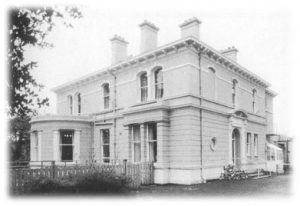 Sir Frederick Cleaver died suddenly on the evening of Saturday 31st March 1936, following his decision to take a walk from his home, Marlborough Park House, to which he had moved in 1927 (left). He had reached Stranmillis Road, when he collapsed and died. He was survived by his wife Lady Sarah Cleaver who died at Broomhill Park in December 1951. Like so many other members of the family, she also took an active interest in the work of the Methodist missions.
Sir Frederick Cleaver died suddenly on the evening of Saturday 31st March 1936, following his decision to take a walk from his home, Marlborough Park House, to which he had moved in 1927 (left). He had reached Stranmillis Road, when he collapsed and died. He was survived by his wife Lady Sarah Cleaver who died at Broomhill Park in December 1951. Like so many other members of the family, she also took an active interest in the work of the Methodist missions. John Cleaver’s eldest surviving daughter, Mabel, was born in March 1877 and in what was not perhaps a surprising move, she married Edward (Ned) Robinson on 12th June 1901 at University Road Methodist Church. Ned Robinson was the eldest son of Edward Robinson, one of the founders of Robinson & Cleaver and was a joint managing director of the firm at Donegall Place. They began their married life at a house on Somerton Park, but following the death of his father in 1906, they moved to a magnificent estate at Shaw’s Bridge overlooking the Lagan named Terrace Hill. It was the sale of the company to Edward De Stein in 1936, that precipitated the couple to demolish the original house of 1856. Ned and Mabel who enjoyed a fantastic social life, built a sprawling new house in an American neo-Georgian style, the design being executed by Young & McKenzie, (who designed the original store on Donegall Place in 1888) and in which they could entertain the cream of Ulster Society. Mabel had two daughters, who were brought up in a very privileged environment. Terrace Hill extended to over 9,200 sq feet, and had beautifully manicured gardens overlooking Barnett’s Demesne to Malone House on the other side of the valley. The house had tennis courts and a swimming pool. The eldest, Gwendoline, married Peter Swann, an insurance broker of the Wirral and left Northern Ireland in 1951, whilst Inez married Thomas Agnew, a land agent in Belfast. They were the last occupants to live at Macedon House at Whiteabbey, before it was taken over by Barnardo’s as a children’s home in 1950, as was Terrace Hill, after the departure of the Clokey family in 1970. Inez died in 1978 without issue
John Cleaver’s eldest surviving daughter, Mabel, was born in March 1877 and in what was not perhaps a surprising move, she married Edward (Ned) Robinson on 12th June 1901 at University Road Methodist Church. Ned Robinson was the eldest son of Edward Robinson, one of the founders of Robinson & Cleaver and was a joint managing director of the firm at Donegall Place. They began their married life at a house on Somerton Park, but following the death of his father in 1906, they moved to a magnificent estate at Shaw’s Bridge overlooking the Lagan named Terrace Hill. It was the sale of the company to Edward De Stein in 1936, that precipitated the couple to demolish the original house of 1856. Ned and Mabel who enjoyed a fantastic social life, built a sprawling new house in an American neo-Georgian style, the design being executed by Young & McKenzie, (who designed the original store on Donegall Place in 1888) and in which they could entertain the cream of Ulster Society. Mabel had two daughters, who were brought up in a very privileged environment. Terrace Hill extended to over 9,200 sq feet, and had beautifully manicured gardens overlooking Barnett’s Demesne to Malone House on the other side of the valley. The house had tennis courts and a swimming pool. The eldest, Gwendoline, married Peter Swann, an insurance broker of the Wirral and left Northern Ireland in 1951, whilst Inez married Thomas Agnew, a land agent in Belfast. They were the last occupants to live at Macedon House at Whiteabbey, before it was taken over by Barnardo’s as a children’s home in 1950, as was Terrace Hill, after the departure of the Clokey family in 1970. Inez died in 1978 without issue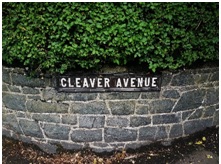 Today there are several reminders of the power and influence of the Cleaver family in Ireland, although there are no remaining family members now resident here. The site of the once magnificent family home and estate at Dunraven, is now covered in villa developments from the 1930s, when the house was sold, and is now known as Cleaver Park and Cleaver Avenue, off the Malone Road.
Today there are several reminders of the power and influence of the Cleaver family in Ireland, although there are no remaining family members now resident here. The site of the once magnificent family home and estate at Dunraven, is now covered in villa developments from the 1930s, when the house was sold, and is now known as Cleaver Park and Cleaver Avenue, off the Malone Road.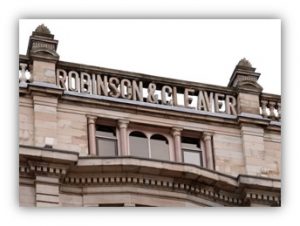 The magnificent department store buildings of Robinson & Cleaver still stand on the Corner of Donegall Place and Donegall Square North, as they do in London, although the family connection with the business was severed in 1936. The achievements of the company in obtaining several Royal Warrants and supplying Royal households across the world was none the less remarkable
The magnificent department store buildings of Robinson & Cleaver still stand on the Corner of Donegall Place and Donegall Square North, as they do in London, although the family connection with the business was severed in 1936. The achievements of the company in obtaining several Royal Warrants and supplying Royal households across the world was none the less remarkable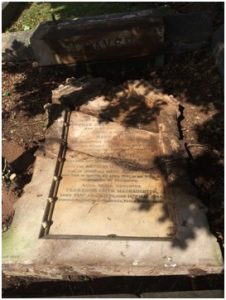 The final resting place of the Irish branch of the family can be found at Belfast City Cemetery, where there are three separate memorials. The saddest of these is the main family memorial which has only recently been revealed having been badly damaged by vandals during the period of civil unrest in Northern Ireland in the 1970s.
The final resting place of the Irish branch of the family can be found at Belfast City Cemetery, where there are three separate memorials. The saddest of these is the main family memorial which has only recently been revealed having been badly damaged by vandals during the period of civil unrest in Northern Ireland in the 1970s.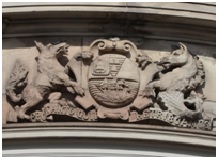
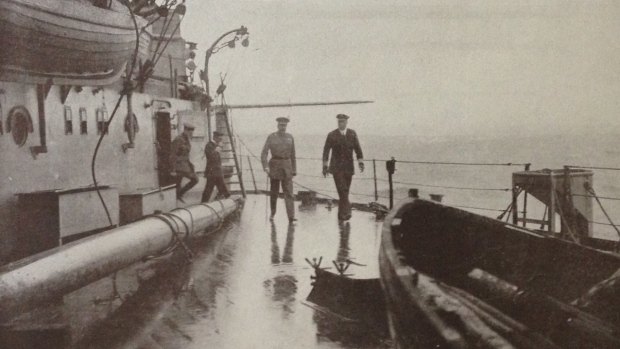
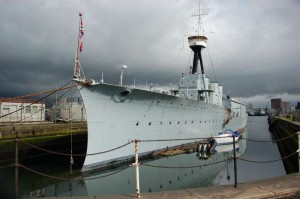 A sea of lights to remember those from North Belfast who died in the First World War.
A sea of lights to remember those from North Belfast who died in the First World War.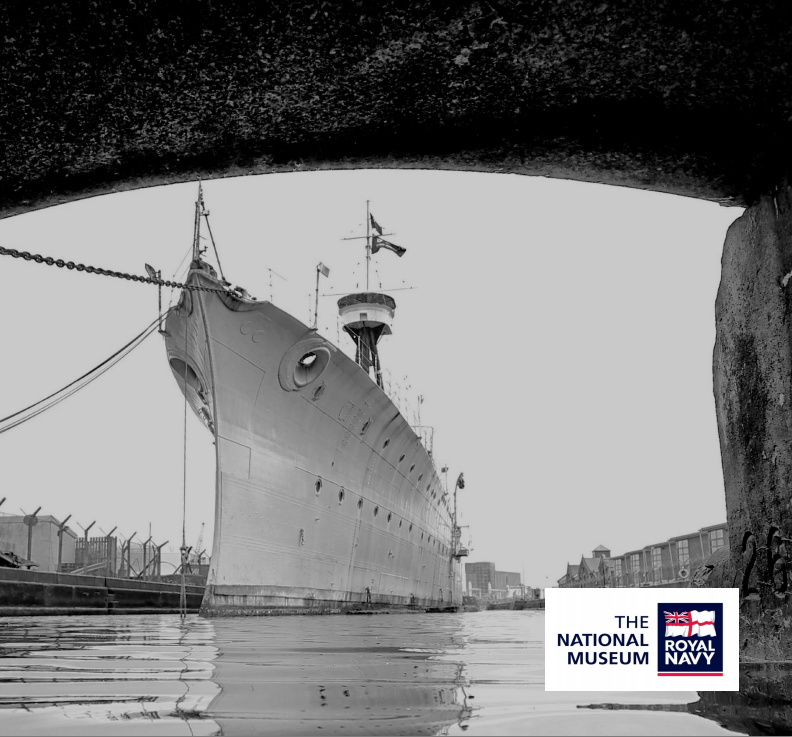
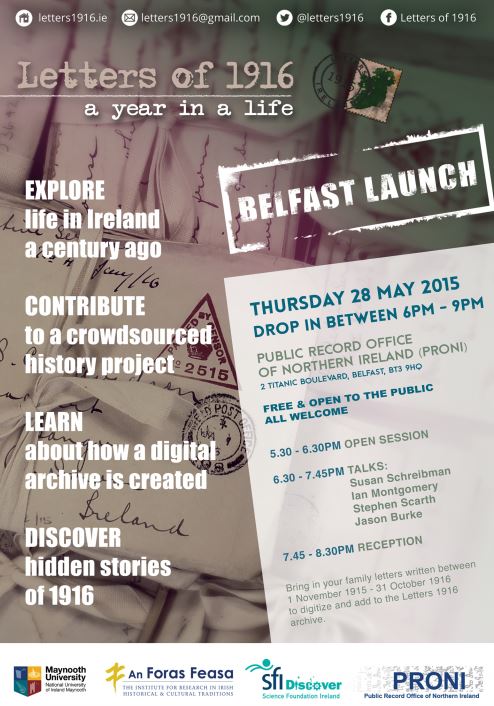

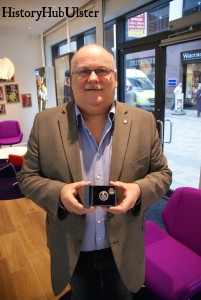 Brian said, “I was browsing in the hope of finding my own grand-fathers lost medals but seeing this badge’s local connection, I believed that it could and should be reunited with Albert Baxter’s family. It was an act of Remembrance really and I posted an appeal on the Facebook page that I administer for the Limerick Branch of the Royal British Legion. Our Belfast following is quite strong and I was confident someone there would be able to help”.
Brian said, “I was browsing in the hope of finding my own grand-fathers lost medals but seeing this badge’s local connection, I believed that it could and should be reunited with Albert Baxter’s family. It was an act of Remembrance really and I posted an appeal on the Facebook page that I administer for the Limerick Branch of the Royal British Legion. Our Belfast following is quite strong and I was confident someone there would be able to help”.